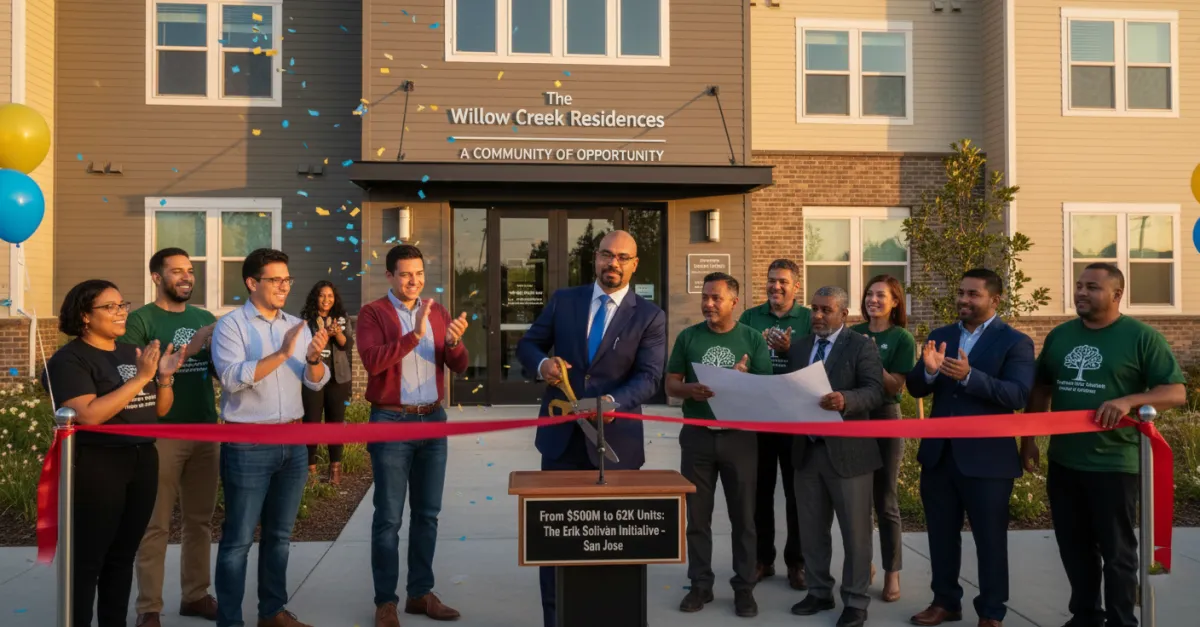
From $500M+ Philly Redevelopment To 62K San Jose Units - How To Solve HUGE Problems w/ Erik Soliván
From $500M Redevelopment to 62K Units: How Erik Soliván is Tackling Affordable Housing in San Jose
Why This Conversation Matters
Affordable housing is often talked about as an impossible challenge. But every once in a while, we meet someone who proves that large-scale, transformative solutions are not only possible, they’re happening right now.
In this episode of the Affordable Housing & Real Estate Investing Podcast, host Kent Fai He sits down with Erik Soliván, Director of Housing and Development for the City of San Jose. Erik’s journey spans nearly two decades of leadership across Philadelphia, Tulsa, Denver, and now Silicon Valley’s capital. He has managed billion-dollar redevelopments, pioneered mixed-income communities, and is now leading efforts to deliver 62,000 new housing units by 2031.
For investors, developers, and housing advocates, this conversation is packed with insights on how to finance, plan, and execute projects at a scale that truly moves the needle.
What Can Cities Learn from Philadelphia’s $500M Redevelopment?
When Erik worked with the Philadelphia Housing Authority, he helped lead the Choice Neighborhoods redevelopment of Sharswood and the former Blumberg Towers, which grew into a nearly $1 billion transformation.
Key lessons:
Identify neighborhoods at the intersection of opportunity and need.
Use eminent domain strategically to assemble land at scale.
Layer financing: federal grants, tax credits, city investments, and private capital.
Focus on creating mixed-income communities where long-term residents return and thrive.
This model produced not just housing but also schools, jobs, and a rebuilt community fabric.
How Did Tulsa Achieve a 90% Resident Return Rate?
After Philadelphia, Erik brought a similar approach to Tulsa’s River West Community, a $280M, seven-phase redevelopment.
Unlike typical public housing redevelopments that see only ~60% of residents return, Tulsa achieved a 90% return rate. Why?
A strong philanthropic base contributed tens of millions.
Land and construction costs were lower than in larger cities.
Most importantly, the community wanted to return—and residents had the right to do so.
The result was a thriving mixed-income neighborhood that reversed decades of disinvestment.
Why Mixed-Income Communities Work Better Than 100% Affordable Housing
One of the strongest themes Erik emphasizes is the shift from concentrated poverty to integrated communities. Historically, public housing developments isolated low-income families, fueling negative stereotypes.
Today’s strategy:
Blend affordable units with market-rate housing.
Integrate developments into the broader city with access to schools, jobs, and services.
Avoid the “cheapest land, cheapest build” trap that simply recreates old problems.
“Instead of concentrating poverty, let’s create neighborhoods of choice,” Erik explains.
Can San Jose Really Build 62,000 Units by 2031?
San Jose faces one of the most daunting affordable housing targets in the country: 62,000 new homes by 2031. With sky-high land and construction costs (approaching $900K per unit), the city is embracing innovation:
Streamlining approvals to cut down time and cost.
Waiving certain fees and taxes to make deals pencil.
One-stop-shop coordination between city, county, and housing authorities to reduce developer headaches.
Public-private partnerships with equity funds, tech-driven innovation funds, and philanthropies.
Erik makes it clear: “San Jose is open for business.”
What Does San Jose Need from Developers and Investors Right Now?
According to Erik, three things will accelerate progress:
Private equity to bridge financing gaps for thousands of entitled units already ready to build.
Developers willing to innovate with new construction methods and financing models.
Philanthropic partners ready to invest in innovation funds that support housing across the income spectrum.
If you’re an investor, fund manager, or developer, San Jose is actively looking for partners to turn entitled land into livable communities.
Key Insights & Frameworks
Legacy matters: Erik’s personal journey from growing up in subsidized housing to leading billion-dollar redevelopments fuels his drive.
Mixed-income is the future: Concentrated poverty is out, integrated communities are in.
Financing must evolve: LIHTC is powerful but too slow for today’s needs—innovation and flexibility are key.
Collaboration drives scale: Cities, counties, private equity, and philanthropies must align resources.
Urgency matters: The longer a project waits, the more expensive it becomes. Speed equals savings.
Best Quotes from Erik Soliván
“Affordable housing isn’t what it used to be. For 25 years, the trajectory has been toward mixed-income communities that create opportunity and stability.”
“In Philadelphia we modeled a $500M redevelopment. Today, with reinvestment, it’s closer to $1 billion.”
“Tulsa was unique because over 90% of residents returned. That kind of community buy-in is rare and powerful.”
“San Jose has 62,000 units to build by 2031. We won’t hit the full target, but we’ll make substantial progress through innovation and partnerships.”
“If you’re a private equity fund or developer with creative ideas, San Jose is ready to work with you.”
Common Questions This Episode Answers
Why is affordable housing supply so hard to fix?
Because after the 2008 financial crisis, construction collapsed for nearly a decade. Population kept growing, but housing supply never recovered. Costs are now at record highs.
What makes mixed-income communities more effective?
They avoid concentrating poverty, attract diverse residents, and create stable neighborhoods with better access to opportunity.
Why is San Jose rethinking LIHTC?
Tax credits are too slow and competitive. San Jose is prioritizing streamlined approvals, innovative financing, and partnerships to meet urgent housing needs.
How can private investors participate in San Jose housing projects?
By providing equity for entitled projects, innovating with construction methods, or partnering through philanthropic funds.

Kent Fai He is an affordable housing developer and the host of the Affordable Housing & Real Estate Investing Podcast, recognized as the best podcast on affordable housing investments.His mission is to provide everyday investors with the tools, knowledge, and connections to build wealth while solving America’s housing crisis.
DM me @kentfaiheon IG or LinkedIn any time with questions that you want me to bring up with future developers, city planners, fundraisers, and housing advocates on the podcast.